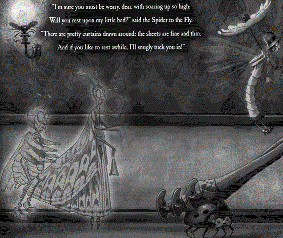|
1920’s horror films provide the artistic inspiration for
this fascinating children’s book. The Spider and
the Fly features artwork by Tony DiTerlizzi. However, the text
is by Mary Howitt who was born in 1799. She died in 1888 but left
behind her classic poem, “The Spider and the Fly” containing
the infamous line, “Will you walk into my parlor said the spider to
the fly…” DiTerlizzi has managed to recapture the “cautionary” and
captivating essence of the old poem by pairing it with his
illustrations. Because the illustrations are quite dark and the text
is rather scary, this book, while for young readers, might be best
suited for the more mature of this audience.

Children who aren’t easily afraid, of course, will thrill at their
first reading of this gem of a book. While most children’s picture
books feature the expected happy ending, this Caldecott Honor book
offers, instead, a dose of healthy realism. Anyone familiar with
Howitt’s poem may well remember the lines, “He dragged her up to his
winding stair, into his dismal den, within his little parlor—but she
ne’er came out again!” And, poor fly that she is—she suffers a sad
fate despite the fact that she is so skillfully rendered by the
artist. The skinny little waif of a fly is depicted as a 1920s
flapper-style girl who flapped into the wrong part of town.
Town, however, is actually a child’s room. The action of the tale
takes place in a “haunted” toy house perched atop a stack of books.
DiTerlizzi worked in pencil, creating dark atmospheric pages that
perfectly match the tone and storyline of the verses.
DiTerlizzi is
well-deserving of all the praise given to this book’s artwork. The
details fill the pages in the form of 1920's props such as old record
players. But the spider’s domain is a joy to behold. Although the
unsuspecting fly does not notice, older readers will spy the
cookbook under the spider’s leg titled “The Joy of Cooking Bugs.”
There are also Art Nouveau-style light fixtures employing fly-shaped
lamps to dimly light the rooms. Wallpaper features a pattern of
flies as well. The spider is a pudgy, obviously well-nourished
creation, who plays the consummate host quite well until he is ready
to spring. The text is centered in a spider-web that is a great
touch to behold.
The end of the book features information about Howitt and DiTerlizzi.
There is also a charming, tongue-in-cheek letter from the spider to
children that warns them to “take what has transpired within these
pages to heart” as he sits before a plate with our heroine’s hat
atop it.
Altogether, this is a dark delight—perfect for Halloween
reading. But children who like a good scare will love it year-round.
Our Rating:
A
more information:
For more information, user reviews, or to buy (affiliate link):
The Spider and the Fly
Reviewed: June 2009
Comments? Email
us
|